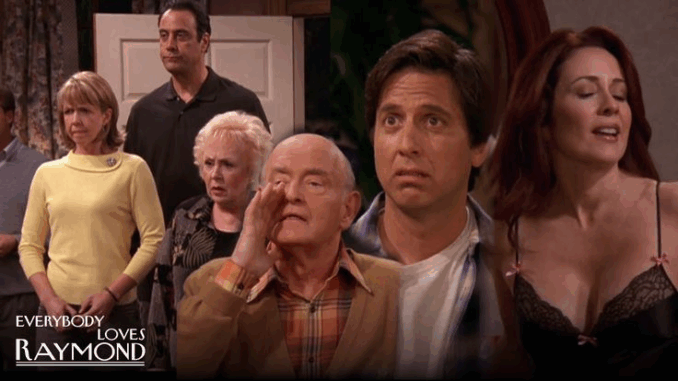
A Throwback to 1996 Sitcom Gold
Back in 1996, Everybody Loves Raymond debuted on CBS with a low-key, family-centric pilot that didn’t scream instant classic—but it had something special. Ray Romano, a relatively unknown stand-up comedian at the time, brought an everyman charm to the screen that made people lean in and chuckle.
Fast-forward to today, and the show stands as one of TV’s most beloved sitcoms. So how did it all begin? Let’s dive into the very first episode—“Pilot”—and see how well it holds up nearly three decades later.
First Impressions: Unpolished But Promising
The pilot episode introduces us to Ray Barone, a sportswriter living in Long Island with his wife Debra and their three young kids. Right off the bat, the tone is clear: relatable, grounded humor rooted in family dysfunction.
It’s not flashy. In fact, compared to the slick sitcom pilots of today, it feels almost underwhelming. But that’s part of its charm. The laughs come from real-life situations, not punchlines crafted in a writers’ lab.
The Premise: Simple, Relatable, Real
A Brother, A Mother, and A Lot of Interruptions
Ray’s biggest problem in the pilot? His overbearing parents live right across the street, and his brother Robert practically lives with them. The situation creates constant interruptions and comedic chaos—especially for Debra, who is clearly not thrilled about their lack of boundaries.
That’s the genius of Raymond. It’s not about wacky scenarios or high-concept plots. It’s about everyday annoyances—and how family makes them even more annoying.
The Characters: Fully Formed from Day One
Ray Barone: Relatable and Dry
Romano doesn’t try too hard, and that works in his favor. His dry, deadpan delivery lands quietly but effectively. He’s not the typical sitcom alpha male—he’s passive, awkward, and avoids confrontation at all costs. And we like him for it.
Debra Barone: The Show’s Backbone
Patricia Heaton’s Debra is instantly likable. She’s overwhelmed, exhausted, and visibly annoyed—but she’s also fiercely grounded. She becomes the voice of reason, and without her, Ray’s laid-back attitude wouldn’t be half as funny.
Marie and Frank: Scene-Stealers
Even in the pilot, Doris Roberts (Marie) and Peter Boyle (Frank) are comedic gold. Marie’s passive-aggressive perfectionism is fully formed, while Frank’s brutal honesty and deadpan delivery give the show an edge.
Robert: The Underdog Brother
Brad Garrett’s Robert adds subtle but effective comedy. He’s tall, gloomy, and lives in Ray’s shadow—which becomes a recurring theme. His lines in the pilot are sparse but land hard.
Top 5 Funniest Moments in the Pilot
-
The “Suitcase Massage” Bit – Ray tries to sneak a back massage from Debra and accidentally reveals that he’s been bribing his daughters to leave the room. Classic Ray move.
-
Marie’s Drop-In Visits – She enters unannounced, bearing food and unsolicited opinions. It’s the beginning of her legendary boundary issues.
-
Frank’s Parenting “Advice” – Frank tells Ray, “You’re raising a couple of wusses.” His unapologetic parenting critiques instantly define his role.
-
Robert’s Lurking Presence – He shows up with a deadpan, “I brought you a fork,” which somehow feels both sad and hilarious.
-
Debra’s Explosive Outburst – She finally breaks down over the in-laws’ constant visits, giving the episode its first true emotional peak—and big laughs.
The Writing: Grounded and Observational
The writing in the pilot leans heavily on real-life humor. It’s not trying to be clever—it’s trying to be real. That authenticity would go on to define the entire series. You feel like you’re watching a real couple argue, not actors performing lines.
Rosenthal’s script doesn’t swing for the fences. It lays a foundation for slow, character-driven growth—and that slow burn is what made the show so enduring.
The Set and Style: ’90s Suburbia Vibes
Everything about the pilot screams late-’90s suburbia. From the wallpaper to the outfits, it’s a nostalgia trip for anyone who grew up in that era. The single-camera format and laugh track feel old-school now, but they serve the cozy, sitcom formula well.
Reception at the Time vs. Now
Then: Modest Start
Critics were lukewarm at first. The show didn’t generate the buzz that Seinfeld or Friends did. But word-of-mouth grew as audiences connected with its understated humor.
Now: Cult Favorite Turned Classic
Looking back, it’s easy to see how this humble pilot laid the groundwork for a long, successful run. Fans now view it as a classic example of how great sitcoms don’t always start flashy—but they grow into something beloved.
Does the Pilot Hold Up in 2024?
Absolutely. While the pacing is slower and the style may feel dated to younger audiences, the core of the humor—family tension, marriage misfires, in-law chaos—remains just as relevant today.
It might not make you laugh out loud every second, but it’ll make you nod your head and say, “Yup, been there.”
Conclusion: A Solid Start to a Sitcom Classic
The first episode of Everybody Loves Raymond didn’t reinvent the sitcom wheel—but it didn’t need to. It quietly introduced us to characters we’d grow to love (and yell at), all while grounding itself in painfully relatable family life. In many ways, the pilot is a perfect example of how the most ordinary stories can make for the most extraordinary television.
FAQs
1. What was the original air date of the first episode?
The pilot aired on September 13, 1996, on CBS.
2. Was the show immediately successful after the pilot?
Not exactly. It had modest ratings early on but grew steadily through strong word-of-mouth and reruns.
3. Were all the main characters in the pilot?
Yes, the entire Barone family was introduced in the very first episode.
4. Did Ray Romano write the first episode?
No, series creator Phil Rosenthal wrote the pilot, though Ray was involved in shaping the show’s tone and humor.
5. Is the first episode a good introduction to the series?
Yes! It sets the tone, introduces the central conflicts, and gives you a taste of the dynamic that would carry the show for nine seasons.
